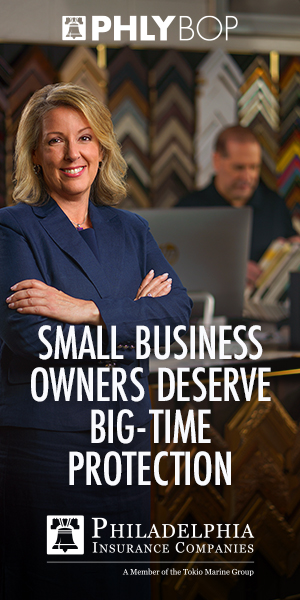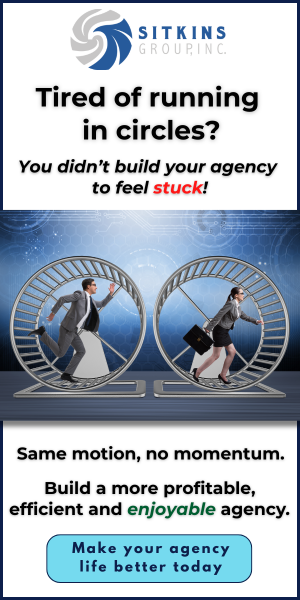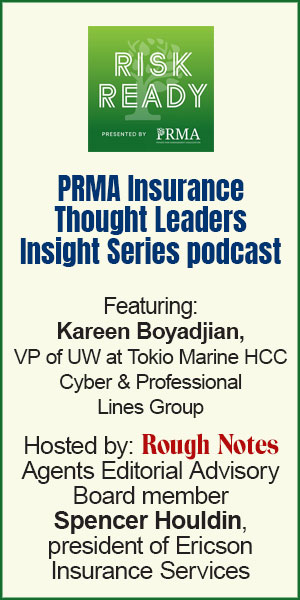It’s 2025, not 2015
[O]ne day you’re reviewing a routine renewal …
and the next, you’re scrambling to explain a risk
no one saw coming.
By Carolyn Smith, APR, TRA
As we head into the final stretch of 2025—the last quarter of the first quarter of a brand-new millennium—one thing’s become impossible to ignore: The world isn’t just changing. It’s picking up speed. Decisions that used to take years now happen in weeks. Trends come and go before we even name them.
And if you’re waiting for everything to settle down … you might be waiting forever.
This is the moment to show up, lean in, and make a difference—while others are still trying to catch up. Because one day you’re reviewing a routine renewal … and the next, you’re scrambling to explain a risk no one saw coming.
It’s not that risk advisors don’t care. It’s that they’re human. And human beings are wired to focus on what’s urgent, not what’s important. That may have helped us survive during the Ice Age. But it’s a terrible way to run a modern risk strategy.
This is where strategic foresight comes in. It’s not about predicting the future. It’s about preparing for it. Seeing around corners. Asking better questions. And helping clients make smart decisions before things go sideways.
That’s because in a world that won’t slow down, the best way to lead is to look ahead.
Enter strategic foresight
Strategic foresight is what separates true advisors from transactional salespeople. Not because they have all the answers—but because they know how to ask the right questions before the storm hits.
It’s not a crystal ball. It’s a mindset. A posture of curiosity, clarity, and courage.
If you’re not helping clients anticipate what’s next, you’re just cleaning up the mess after it arrives. And these days? The mess shows up fast.
So—strategic foresight doesn’t make things easier. It makes you indispensable.
What’s getting in the way?
Why do so many advisors get stuck in reactive mode? It’s not because they lack expertise; it’s because they’re trapped in a system that rewards short-term thinking and penalizes long-term planning.
Let’s break down the real barriers:
- Organizational pressures. Advisors are constantly pulled toward tight timelines, reactive cultures, and internal metrics that reward short-term wins over long-term resilience.
- Overreliance on historical data. Many risk advisors rely solely on loss runs and claims history. But risk is no longer just about what has happened; it’s about what might happen next.
- Siloed thinking. Risk, operations, HR, finance—everyone has their own language. But risk doesn’t respect organizational charts. When departments don’t talk, the big picture gets missed.
- Lack of time for thinking. When you’re constantly firefighting, you have no time to step back and see patterns. Foresight requires whitespace—time to think, imagine, and explore scenarios.
- Fear of being wrong. Let’s be honest—forecasting feels risky. Many advisors stay in their lane, offering “safe” advice rather than venturing into the uncomfortable terrain of the unknown.
- Limited client engagement. When clients engage only during renewal season, the conversation is already behind. Strategic foresight depends on deeper, more frequent discussions—about their business model, not just their insurance policy.
- No framework or process. Without a repeatable way to scan trends, run scenarios, and prioritize future risks, foresight feels fuzzy and ungrounded. And it gets dropped.
- Coverage gaps in crisis, catastrophe, and cyber. Many organizations lack protection against the very events that can dismantle them. A lack of cyber liability, no business income coverage, or insufficient crisis response plans are signals that the real risk isn’t being addressed. These aren’t just coverage gaps—they’re foresight failures.

Grey Rhinos: The real threats are in plain sight
We talk a lot about Black Swans—rare, unpredictable events. But in reality, most disasters aren’t surprises. They’re Grey Rhinos—obvious, high-impact risks that we ignore until it’s too late.
Think about it:
- Climate change
- Aging infrastructure
- Workforce shortages
- Emerging technologies
- Changing regulations
These threats aren’t hiding. They are marching straight at us. And yet, most organizations act surprised when they finally arrive.
Why? Because we’ve built systems that reward short-termism.
- Boards are fixated on quarterly returns
- Leaders are trapped in election or budget cycles
- Risk advisors are chasing renewals, not resilience
Every time we ask “What now?” instead of “What if?”, we delay the hard questions and invite preventable disasters.
Strategic risk isn’t just isolated. It’s systemic.
The real risk today isn’t a single point of failure; it’s the domino effect. In a hyper-connected world, systemic risk is the new frontier. And it doesn’t show up one department at a time.
It shows up all at once.
- A cyberattack that locks up global supply chains
- A water conflict that ignites food shortages
- A regulatory shift in one country that sends ripples through entire industries
These aren’t science fiction scenarios. They’re plausible. And they’re already playing out.
And here’s the kicker: Diversification won’t save you from systemic collapse.
If your risk advisory approach is still siloed—compliance over here, insurance over there, operations in another room—you’re playing checkers in a chess world.
So, what’s the fix?
Strategic foresight isn’t about predicting the future perfectly. It’s about developing the muscle to spot weak signals, test assumptions, and help clients make smarter bets today, so that they’re not blindsided tomorrow.
Jason Robinson, TRA, vice president of sales for O’Neill Insurance, recently met with a church prospect and reviewed their current insurance policy. Everything looked standard—property, general liability, and event coverage were all in place. But something critical was missing.
There was no sexual abuse liability coverage. No counseling liability coverage. These weren’t optional add-ons—they were essential protections for any organization working with children, youth, or vulnerable individuals.
The church had no idea. They assumed they were covered. No one had ever brought it up. But the gap was there—and it was wide.
Robinson didn’t scare them. He educated them. He explained the exposures, showed them what was missing, and helped write a new policy that filled the gaps and aligned with the church’s mission and activities.
That’s strategic foresight.
Because it’s not just about responding to claims. It’s about identifying invisible risks before they become front-page problems. And in a world where trust can be lost in a moment, having the right coverage in place isn’t just good stewardship. It’s essential leadership.
The best risk advisors:
- Use scenario planning to pressure-test strategies
- Lead risk audits that go beyond insurance coverage
- Create collaborative spaces where finance, HR, and ops can align
- Coach clients to reallocate resources (e.g., increase coverage on their most vital buildings, cut coverage on those they can live without)
A couple of years ago, Jordan Schram, CIC, TRA, a risk advisor with Associated Insurance Services, noticed something: One of her longtime clients had always passed on cyber liability coverage. “Too expensive,” they said. “We don’t really need it.”
But then they made a change. They started accepting credit card payments.
That’s when Jordan leaned in. Not with fear. Not with pressure. But with empathy—and the kind of foresight that turns risk into responsibility. “I saw this as my opportunity to educate them a bit more regarding cyber liability.”
She asked two simple questions: “What would happen if your system was hacked and your customers were impacted financially as a result? Would you be able to cover these costs financially as a small nonprofit?”
Those questions changed everything. They had been under the impression that as a small nonprofit, they wouldn’t be the target of a cyberattack. Schram explained that they could be a more likely target due to being a small business—hackers would probably assume that they wouldn’t have security measures that larger corporations tend to have.
“I explained that even if a small amount of money is stolen because of a breach, the forensic investigation into the breach could be costly. When they reviewed the quote along with real claims examples that other small businesses have encountered, they decided to purchase the coverage along with a crime policy that they ultimately decided was necessary,” she said.
She helped them see what they hadn’t seen before. She explained the exposure. She showed them what was missing. And then she built out both cyber and crime policies that protected not just the business, but the people who trusted it.
That’s foresight in action. Not just protecting the past—but building resilience for what’s next.
If your client lacks crisis, catastrophe, or cyber coverage, that’s not just a gap in insurance. That’s a gap in imagination. Strategic foresight fills it.
The future favors the prepared
Being a risk advisor isn’t about having all the answers. It’s about being the one who’s not afraid to ask clients and prospects the hard questions:
- What risks are hiding in plain sight?
- What systems are interconnected in ways we haven’t considered?
- What assumptions are we relying on—and what happens if they break?

Clients don’t just need a quote. They need a guide, a trusted advisor who sees what’s coming before it makes headlines.
Be that guide. Show up with insight, not just information. Build for the future—not just the next renewal.
The biggest risk in 2025? Is thinking like it’s still 2015.
The author
Carolyn Smith, APR, TRA, chief training officer for Beyond Insurance, creates and delivers transformative programs, including the Trusted Risk Advisor certification, BIGN Producer Boot Camp, and Quest for Success, that have positively impacted the lives and careers of countless professionals. These programs help industry professionals build a career that they love and achieve the success they deserve.






